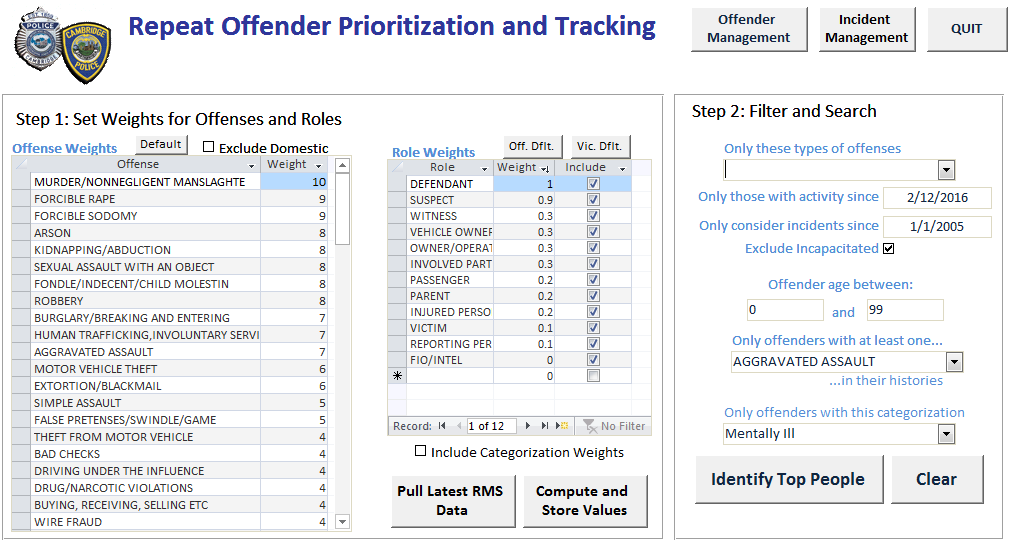
Center for Problem-Oriented Policing
POP Center Responses Focused Deterrence Page 5
PHASE 2: High-Risk Individual Selection
After establishing the basic structure of an FDI and securing the necessary commitments from key partners, you should consider how and on what basis an FDI intervention would target high-risk offenders.
The process adopted to select high-risk offenders for inclusion in the FDI must be objectively fair, and the high-risk offenders must not believe they were targeted arbitrarily or randomly but rather because of the frequency and/or severity of their criminal behavior.17 High-risk offenders must believe that they can cease being law enforcement targets by changing their own behavior, that they can control what happens to them, and that they bear responsibility for being a targeted person. It is equally important that judges, defense counsel, probation and parole officers, offenders’ families, and the general public believe that the criteria for targeting high-risk offenders are fair and lawful.
Initially, you must decide what type of high-risk offenders to focus on. Most early FDIs have chosen to focus on violent gang-affiliated or drug-market offenders. Alternatively, the initiative could focus on chronic nuisance offenders or on domestic violence offenders. Some police agencies have considered testing the approach on chronic drunk drivers; to date, this has not been done.
Second, you must decide, within the general type of offending being targeted, what threshold of frequency or severity of offending will qualify an individual for becoming a target. Will the most prolific offenders be targeted? The most dangerous? Or some blend of the two?
Third, you must decide whom to target among those who meet the objective criteria listed above. In some early FDIs, decision makers preferred targeting individuals who were believed to have special influence within criminal networks (i.e., so-called “shot-callers,” “impact players,” or carriers of criminal ideas and motives).18 The logic is that by changing the attitudes and behavior of these individuals, there is greater likelihood of indirectly changing the attitudes and behaviors of others whom they influence. Though social influence is more subjective than other factors, such as the number of prior offenses, you should make an effort to base the selection criteria on reliable evidence, not on hunches, speculation, or dislike of an individual.
Selecting the right individuals to target requires a blend of documented evidence of prior offenses, law enforcement practitioners’ understanding of offenders’ motives and social influence, and a deliberate process for choosing from among target candidates. You should strive to reach consensus among partner agencies and organizations as to the specific criteria. Among critical criteria that argue in favor of targeting a particular individual are the following:
- The candidate has significant influence among other offenders
- The candidate is personally involved in committing or ordering violent acts
- The candidate is currently engaged in illegal activity
- The candidate is vulnerable to official criminal justice intervention (e.g., is a suspect in an active police investigation, has pending criminal charges, or is in the community on conditional release from jail or prison)
You and others selecting individuals for FDI attention should also consider the criteria for formally removing an individual from focused-deterrence attention. Obviously, if an individual is reincarcerated or dies, they would be removed from FDI attention, but because FDI attention entails both heightened risk of punishment as well as heightened social services, formally removing individuals from FDI attention is not always going to be in individuals’ best interests.
…from my experience, many offenders in [focused-deterrence initiatives] do not know or understand why they have been singled out. As hard as it is to believe, offenders often do not comprehend the extent of their criminal histories, and they end up expressing feelings of being unfairly singled out. So, part of a good FDI is to educate the offenders on why they are part of it.
Lieutenant (Ret.) Tom Woodmansee, Madison (Wisconsin) Police Department (Woodmansee 2015)
Cambridge/Somerville/Everett, Massachusetts, SPI Case Study: Offender Selection
The Cambridge/Somerville/Everett (Massachusetts) FDI was nontraditional in several ways. A key difference from most FDIs was in Phase 2: Offender Selection. Not only did the pool of potential offenders come from three separate jurisdictions that were combined into one database, but much wider criteria were also used for the selection decision. Whereas most FDIs focus on either violent offenders or one specific type of offender (i.e., drugs or domestic violence), the Cambridge Police Department-led effort created a “social harm index” to select the offenders on whom to focus. They believed that many of the most prolific people were not only committing crimes, but also involved in social harm in other ways that affect the public and police.
This data-driven approach included several steps. All people (not just offenders) who were in the three participating police departments’ records were combined into a custom-designed database. Every offense was given a weight based on comprehensive empirical guidelines established by the Massachusetts Sentencing Commission. This offense score, along with the person’s role and how recent the incident was, were inputs to an algorithm created to calculate a total score based on every contact for every person in the database (see the graphic below for a screen shot of the system). The ability to filter and search by age, crime type, and category was also provided. This allowed specialized units to create custom lists to prioritize their work (e.g., homeless, juvenile, mentally ill). One type of analysis that was done to confirm the importance of this selection focus was comparing the percentage of offenders responsible for the percentage of crime versus social harm. They found that 10 percent of the offenders were responsible for 26 percent of the crime, but that 10 percent of the offenders were responsible for 70 percent of social harm.
